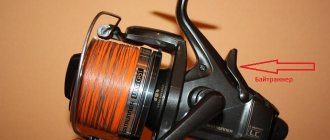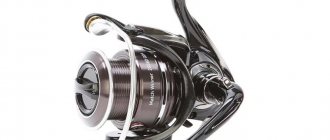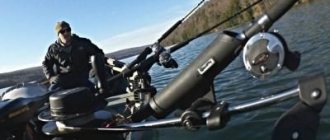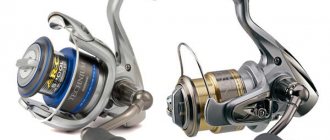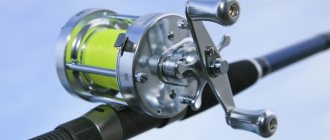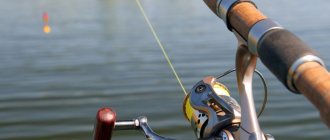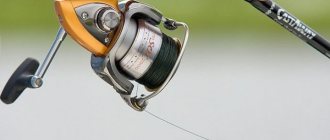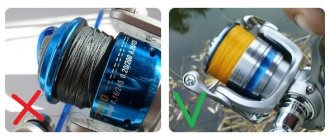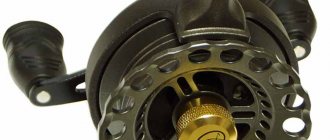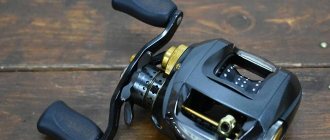- Types of friction brakes
- Why do you need a bayrunner?
The reverse brake device of the spinning reel was created with the purpose of being able to extract large fish from a reservoir with thin equipment by lowering the line with a sharp increase in load.
Unfortunately, not many fishermen know how to use this mechanism, believing that the reel is a kind of reel for winding line and adjusting its length. However, correct adjustment of the clutch allows you, when catching a trophy, not to break the form, not to tear the line, not to straighten the hook and remove the fish from the water.
Types of friction brakes
The essence of the clutch action is that it is adjusted to a given force using a special regulator. For example, if the thread can withstand 8 kilograms, then the brake is set to 5-6 kg. When the hooked fish makes a sharp jerk that exceeds the breaking capacity of the line, it will remain intact.
In this case, the scaffolding will begin to peel away under the influence of the load, as the friction brake will operate. That is why there should be a significant supply of monofilament or braid on the spool, so that when catching a catfish you will not regret the saved meters. You can read about the methods in the article “Fishing with a spinning reel depending on the conditions and fishing method.”
Depending on their location on the inertia-free clutch body, clutches can be designed in the following options:
- Front location
. This location of the adjusting screw and brake is considered classic, while the entire structure is made on a spool. When the spool is replaced, the brake mechanism also changes. Such inertia-free forks are considered to be high-speed, since they are designed for the use of scaffolding with a small cross-section and light load. This type of friction brake is very finely adjusted; per click the force changes by 200-300 g. - Rear location
. The adjustment screw is located in the back of the case, which is considered much more convenient, since it does not interfere with the wood. But this type takes place in power meat grinders, whose purpose is feeder, trolling, carp phishing. The adjuster pitch on rear-wheel drive clutches is approximately 500 grams. If you use a thread with a small cross-section, then with one mark of the adjustment knob it will come off quite easily; when tightened by one click, the force for it will become critical.
The brake of a spinning reel is more comfortable, the greater the number of parts on which the load falls are in contact with each other. In the rear-wheel drive clutch, the emphasis is on Teflon washers, in the front-wheel drive - thanks to the entire surface area.
If the reverse brake on a spinning reel has disappeared, this indicates that it has not been properly maintained and water has penetrated inside the housing or the lubricant has simply thickened. There are, of course, other reasons that require the intervention of a specialist, but in the event of a blockage, it is enough to carry out maintenance yourself.
What is the rear clutch for in a reel: features of the friction brake, advantages and disadvantages
In the modern world, fishing remains an integral part of the life of the population. Some people are interested in fishing in the summer, while others prefer winter fishing. Sport fishing is gaining more and more popularity, the peculiarity of which is that the entire catch is sent back to the reservoir. Indeed, for many people this type of activity has become not only a way to earn money, but also a regular hobby.
In this regard, fishing equipment began to develop and improve widely. One of such equipment is a fishing reel, the presence of which makes it much easier to catch big fish.
Purpose of the friction brake
Currently, most fishing rods, spinning rods and donkeys are equipped with reels. For a good catch you need to know how to use them correctly. For some, a reel is just the place where the fishing line or device is located, designed to allow you to cast gear as far as possible.
But for some anglers who know why a drag is needed, this device helps them bring truly exclusive species of prey to shore. Indeed, a flexible fishing rod and skill when working with the drag guarantee the angler to catch a big fish without breaking the tackle, without breaking the fishing line or bending the hooks.
Typically, coils consist of:
- a solid body made of metal, plastic or carbon fiber, with a mechanism inside and a special attachment to the rod,
- rotor, which is equipped with a moving line guide bracket,
- fixed spool for storing fishing line,
- handles that set the entire mechanism in motion,
- friction brake.
The friction brake is one of the most important components of an inertia-free spinning or feeder fishing reel, which is designed to preserve the fishing line from damage, and the tackle and rods from damage to their integrity under heavy load. The clutch also smoothes out sudden movements of the fish and prevents it from escaping. Thanks to the friction system, it was possible to use thinner lines to catch larger fish.
Correct clutch setting
Surprisingly, many anglers ignore the friction brake device because they don’t know how to set it up or don’t want to use it. And some fishermen simply forget about it, trying to quickly catch their treasured trophy.
Also, unfortunately, there are those fishermen who simply do not have the funds for good reels and have to buy cheap and low-quality ones, not made in the best way and quickly breaking down.
As a result, it turns out that in one case the brake is fully tightened, in the other it is weakly tightened or not tightened at all.
For those who do not know how to use a clutch, there is the following adjustment technology:
- A reel with a fishing line wound on it is attached to a fishing rod, then the fishing line is threaded through the guide rings and tied to something stationary.
- The line laying arc is reset. The fishing rod is placed at an angle of 45 degrees and the arc is closed back.
- Slowly rotate the reel handle until the rod tip bends.
- By turning the clutch adjustment mechanism counterclockwise, we find the moment it operates.
- With small jerks of the fishing rod you need to check whether the line is coming out of the reel. Thus, the clutch must operate before the maximum tension is reached, at which a breakage may occur.
However, this is not the end of the shore inspection. There are several more important adjustment details directly during the fishing process:
- After hooking a fish that gradually begins to move away from the shore, you need to monitor how much fishing line is left on the reel and gradually tighten the clutch adjusting screw. In this way, resistance is created, and the fish quickly gets tired, which will allow you to quickly pull it ashore.
- When playing fish, there is a risk of the clutch tightening on its own. As a result, the force on the line increases, which is why it simply cannot stand it and breaks. In this case, the fisherman constantly needs to monitor the spool and, if necessary, unscrew the adjusting screw.
Advantages and disadvantages of equipment
The advantages of the rear friction brake include:
- Ability to keep the fishing rod and gear intact.
- Smoothing out the jerks of the fish, thereby preventing it from escaping.
- Easy to adjust both before and after fishing.
- The spool is fixed to the rod with a button, this makes replacement easier.
- Can help when casting long distances with thin line.
The disadvantages of the rear friction brake include:
- A more complex braking mechanism, which makes the reel bulky and inconvenient.
- A fully tightened clutch will damage the line.
- Relaxation of the clutch inhibits hooking.
- Capable of self-retracting during fishing.
A friction brake can be useful in certain conditions, and vice versa. However, when in doubt, it is worth setting the clutch in favor of hooking, because during the bite you can have time to loosen or tighten it. Therefore, correct adjustment of the clutch is the key to fishing success and a guarantee of coming home with a good catch, and not empty-handed and broken gear.
Loading…
Source: https://berlogakarelia.ru/snasti/dlya-chego-ispolzuyut-zadniy-friktsion-v-ryibolovnoy-katushke
Why do you need a bayrunner?
The use of a baitrunner on a reel is new and unusual for many anglers. The mechanism serves to disable the friction brake, that is, in a critical situation, just turn the lever, and the line will begin to freely come off the spool. We wrote about this in the article “How to adjust a spinning reel while fishing.”
The system not only adds comfort when fishing, but also protects against the rod falling into the pond when biting very large specimens. To do this, you need to configure the system, cast the tackle, place the form on the stands and turn on the baitrunner.
Even if a fish suddenly jerks the tackle with force when biting, the rod will remain in place. Before hooking it, the mechanism must be turned off, in which case the friction brake will be activated. Let's consider the advantages of this mechanism.
- spinning rods with a baitrunner are considered universal, as they are applicable with feeders, carp blanks and heavy spinning rods;
- have good friction brakes with a sufficient range of settings;
- the coils move easily;
- levers and switches are securely fixed;
- there are no backlashes;
- made of good plastic.
True, there are some drawbacks: high cost, heavy weight, plastic case. The bayrunner is made in the form of a lever, which, when turned on, activates the auxiliary brake mechanism. The main thing is to choose the correct mode for turning on the device.
The baitrunner is set up a little softer compared to the friction brake in order to instantly lower the line when reeling in. However, if you do exactly the opposite, the system will not work, since the scaffolding will be lowered due to the friction clutch. If it is located in the front zone of the reel body, then the degree of load must be adjusted using the baitrunner.
www.udim.ru
Many amateur fishermen have a question about choosing a spinning reel for an ultralight. I want to share my own experience. At the moment, the fishing market is so oversaturated with the choice of spinning reels that sometimes novice spinners, having tried to figure it out on their own, stop halfway, never leaning towards one or another brand of reel.
What should you pay attention to when choosing a spinning reel for an ultralight first of all?
Reel weight and size. A beginning spinning angler must understand that the reel must be combined and balanced with his rod. And if we are talking about an ultra-light spinning rod, then, accordingly, the reel should be as light as possible. The weight of the reel depends on the composition of the body (plastic, graphite, metal, magnesium, etc.) and the size, which is indicated by numbers. For example: 1000, 2000, 3000, etc. But, there are brands that mark their reels differently, for example: 20, 25, 30, etc. Therefore, it is better to know at least the markings of one brand, for example, Shimano, and compare their sizes with other brands of reels.
Number of bearings. Internal bearings are responsible for the smooth running of the reel, but you should not chase the number of bearings. 5-6 bearings are enough for easy, smooth running of the reel. The main thing is that the bearing is in the rotor of the line guide. If there are more than 10 bearings in the reel, this is not bad, the main thing is that the main bearings are metal or ceramic.
Laying the cord. Ultralight tackle involves the use of thin cords, so when choosing a reel it is important to know that the reel should work well with thin cords and not shed loops, forming “beards”. There are two mechanisms that are responsible for high-quality winding of the cord, these are an endless screw (worm) and X-SHIP. Yes, of course, the reel, having one or another mechanism, lays the cord more evenly. But we cannot say that this applies to all reel models. In addition, such reels cost a reasonable amount of money. Therefore, at first, if you have a limited budget, I would not recommend focusing on this.
Backlash in the coil. Any inertialess reel has backlash, no matter how much it costs, but to varying degrees. It is important that the play of the spool along its axis and the play of the joint of the handle in the reel are minimal.
Gear ratio. Gear ratio is a parameter that means how many revolutions the line guide makes per revolution of the reel handle. This parameter is indicated on the box or on the coil body: 4.0:1, 5.0:1, 6.0:1. One represents one revolution of the reel handle, while the other numbers indicate the number of revolutions of the line guide. The higher the speed of the line laying machine, the faster the reel and vice versa. The standard for any spinning reel is a gear ratio of 5.0:1.
Friction brake. There are two types of friction brakes - front and rear. For spinning fishing, reels with a front drag are best suited; they are more reliable and convenient. The clutch itself is responsible for releasing the fishing line during strong jerks of the fish. This is necessary to avoid breaking the cord or fishing line - the main thing is to set the clutch correctly. In ultralight fishing, and not only, it is important that the friction brake is smooth. The number of fish runs and line breaks directly depends on the quality of this mechanism.
Probably like any other responsible angler, at the beginning of this fishing season I started going through all my fishing equipment and noticed a large gap in the spinning reels. I didn’t have enough reels that the rods required, and some were completely out of order and needed replacement.
th eyes fell on the Okuma coils. Why Okuma? Yes, it's actually simple. Due to the rise in the dollar, reels popular among spinning players: Shimano and Daiwa, have jumped up in price and have become unattainable for many, including me. And the price tags of Okuma brand spinning reels suit me quite well. In addition, the entire line of this manufacturer has a very nice design. However, it’s not just the appearance; the parameters and characteristics of these reels more than satisfy me. So why not try and settle on Okuma coils?
More than 4 months ago, the new 2021 Okuma Inspira 25R . This reel is designed for light weights and goes well with ultralight rods. The drag load on the Inspira 25R reel is 3 kg. This is more than enough for a reel of this class.
The reel body is made of light graphite S-40X. The weight of the reel is only 215g. – this is exactly the figure that I would not recommend going beyond when choosing a spinning reel for an ultralight. This weight is optimal for ultra-light fishing rods of various types and classes. Honestly, I don't remember any other reel in this price range with these characteristics.
If we talk about spool volume, then the Okuma Inspira 25R size is equal to 2000 according to Shimano. A smaller spool volume will affect the casting distance and the speed of landing fish.
Also, the Inspira model comes with a spare ceramic spool. It is very convenient to have one reel for ultralight with 2 spools, one of which has a cord for microjig wound on it, and the other spool has monofilament for mormo spinning or crankbaits with spinners. The only downside of these spools is that they are deep, you have to wind too much backing to fill the spools completely.
The Okuma Inspira reel contains 8 anti-corrosion ball bearings, which ensure easy and smooth running.
The reel copes well with thin cords, which once again confirms that it is suitable for working with light weights. When the cord is fully wound, there are noticeable 2 gaps in the upper and lower parts of the spool, but this in no way affects the casting and resetting range of the loops.
The Inspira reel has a slight play in the handle and spool, but again, this is inevitable and not critical for fishing.
The gear ratio in the Inspira is the same as the spinning reel standard - 5.0:1.
It is impossible not to note the very pleasant EVA handle, which fits comfortably in the hand.
As for the friction brake, it is quite sensitive, which allows you to adjust it exactly to the weight and size of the fish you are going to catch.
I think that the Okuma Inspira 25R reel will be appreciated not only by fans of microjig, but also by mormo spinning rods.
NHNCH everyone!
spinningline.ru
Classification
Let's consider the location of the clutch on the reel and what such a device gives to the angler.
There are spinning reels with front and rear friction brakes. If the former, as a rule, are used for spinning fishing, then the latter are used for feeder rods. There is also a system that combines these two brakes. She's called a Bayrunner.
Each of the systems has the right to life and has its own positive and negative features.
The front friction brake is more sensitive than the rear.
Therefore, it is most often used for ultralight fishing:
- The adjustment is made using a special screw that secures the spool. Because of this, you have to spend a significant amount of time changing it.
- It is believed that reels with a front brake are more reliable, as they are equipped with a mechanical circuit.
- In such reels, winding can be adjusted by placing washers under the spool.
Reels with a rear-mounted friction brake differ from the previous ones in a number of parameters:
- Allows you to adjust the tackle even while fishing.
- The spool can be changed with a simple press.
- The cost of the spool is much lower.
- The clamp washer and nut are missing. When changing spools there is a risk of losing them.
The baitrunner allows you to dampen sudden jerks of the fish before hooking. After hooking, you need to switch to the front clutch.
- Such coils, together with a marker float, can be used to check the depth of a reservoir.
- Prevents the rod from falling into the water from the stand.
- The mechanism itself, due to more precise balancing, is less susceptible to vibration and operates more smoothly.
The purpose of a single rear and front clutch is to land fish after hooking. In the case of using a baitrunner, the purpose of the front clutch is fishing, and the rear clutch is to adjust the force of free rotation of the spool before hooking.
Today, models with three clutches have appeared on the fishing reel market.
- The third “fighting brake” is designed for landing large fish.
- Each of the three brakes has a different ratchet sound. Thus, it is easier for the fisherman to determine which of the clutches is working at the moment.
Friction brakes, purpose, types, strengths and weaknesses
The braking system in fishing reels has been around for a long time. Inertial models were also equipped with various ratchets and pressure washers. A revolutionary breakthrough in this direction occurred with the advent of inertialess reels.
Due to the special design of the “meat grinders,” friction brakes had to be invented. Thanks to the new system, it was possible to use thinner fishing lines for catching fish. There are several options for braking systems.
When choosing a reel in a store, it is important to pay attention to the features of the clutch.
Why do you need a brake on the reel?
When buying a fishing reel, many people have a question: what is a friction brake? It turns out that this system is very useful when fishing.
- To pull the treasured trophy ashore, the tackle must withstand the resistance of the fish. And if individual representatives of the ichthyofauna behave quite calmly when hooked, then some species of fish show their violent temperament. How can an angler guess the thickness of the fishing line? It is the diameter of the thread that determines the breaking force that the fishing line can withstand. If the packaging indicates that the thread can withstand a weight of 2 kg, then it is enough for the fish to apply a force exceeding this value, and the angler will be left without a leash or equipment. You can, of course, put a thick cord, but then you will have to wait for more than one fishing trip for a bite.
- Reels equipped with a friction brake help solve this problem. Its operating principle is as follows. The spool of the spinning reel is in a static position, and the line guide rotates around it. It is operated by a reel handle. Before casting the bait, the friction is adjusted in such a way that when the maximum breaking force of the fishing line is reached, the spool begins to rotate, giving the fish a certain length of thread. When set correctly, the trophy quickly tires because the brake provides resistance. As soon as the fish's strength is exhausted, the angler can rewind the line again and bring the prey to the shore or boat.
Photo 1. Spool of an inertia-free reel.
To summarize, it can be clearly noted that thanks to the friction brake, thinner lines can be used, which increases the chances of catching wary fish.
How does the clutch work?
The friction brake on the spinning reel will save the line from breaking during fishing or when the hook gets caught in seaweed if it is set correctly. For adjustment there is a special screw, which can be located in front of the spool or on the back of the body.
- If you fully tighten the screw while rotating it clockwise, the spool will be tightly fixed. In this position, anglers most often tear out the equipment with a dead hook.
- If the adjusting screw is completely loosened, the slightest impact on the line will cause the spool to rotate. Thus, the length of the equipment will increase, and the supply of fishing line on the spool will correspondingly decrease. But without a brake you won’t be able to pull out even a small fish.
- Ideally, the fisherman needs to find such a position for the clutch so that the line release begins only when the maximum load on the thread is reached. Experienced fishermen devote a lot of time to fine-tuning.
Note!
If the clutch on a cheap reel is prone to jamming, then it is better to loosen it by about half the breaking force of the fishing line.
The setup technology looks like this.
- First, the reel with fishing line is installed on the fishing rod. The thread is pulled through the passage rings. The end of the fishing line is tied to a static obstacle (tree, pole).
- The line guide bracket must be reset. The rod is installed at an angle of 45 degrees. The bracket closes.
- Now slowly rotate the reel to tighten the line so that the tip of the fishing rod bends.
- By rotating the adjusting screw counterclockwise, you need to find the moment the clutch operates.
- By lightly twitching the rod towards yourself, you need to check whether the line is released during jerking. As a result, after adjustment, the system should operate when 2/3 of the maximum load occurs.
Recommendation!
Experienced fishermen then release the brake another quarter turn of the regulator. At the end of fishing, it is recommended to completely loosen the clutch to extend its service life.
However, tests on land are not conclusive. When the fish, after hooking, begins to win back meter by meter of line, it is important to monitor how much thread is left on the spool. Often, fishermen, enjoying the “song” of the clutch, do not notice how the spool is emptying, and then an unfortunate break occurs. All equipment remains in the water.
Modern spinning reels are equipped with braking systems of various designs. Each of them has both strengths and weaknesses.
When choosing a reel, experts advise following the following principle. For float or spinning fishing, it is preferable to equip the tackle with models with a front clutch. For those anglers who have chosen feeder or carp fishing, it is better to pay attention to power reels with rear drag. Having a baitrunner is justified when targeting carp and carp.
Source: https://fishelovka.ru/gear/konstruktivnye-osobennosti-frikcionnyh-tormozov-v-katushkah
Setup and adjustment
The line release system is designed to create a certain force when bleeding the line. It is necessary to configure it in such a way as to avoid breakage of the gear.
A properly configured brake bleed system will help in the fight for the catch:
- To begin with, you should tie the main fishing line to a tree or any stationary object.
- When pulling the main line with the rod, it is worth adjusting the friction brake screw.
- The ideal ratio will be when your line braking system starts to operate 1 kilogram less than the breaking load of the main line.
- Experienced fishermen use a steelyard for this. First, they check the actual breaking load of the fishing line, and then adjust the clutch to a lower force.
You should not adjust the release by direct tension of the line from the reel without using a rod. During fishing, part of the load falls on the form itself. Thus, such an adjustment will not be completely reliable.
And yet, no matter what features one or another reel has, the choice is always yours.
orybalke.com
The essence of the work
The principle of operation of the friction brake is quite simple and understandable to any fisherman who has studied a little school physics course:
- The mechanism is adjusted by rotating the regulator to a specific load;
- If during fishing the applied load on the reel clutch exceeds the set value, then the brake is activated;
- The fishing line is released from the spool until the inertia of the fish’s jerk is exhausted.
A properly adjusted friction brake of the reel allows the angler to successfully fight with trophy fish, the weight of which can significantly exceed the breaking load of the line used. For example, there are often cases of fishing for pike weighing 7–8 kilograms with thread, with a stated nominal strength of about 5 kg.
Types of clutches
Despite the various types of fishing reels, spinning reels have only two types of friction mechanisms:
- front;
- rear.
The front clutch is located on the spool. This option is more popular and in demand among spinners because it has the following advantages:
- Less inertia-free weight, which has a positive effect on the balance of the assembled tackle;
- Simplicity and reliability of the design, which implies the durability of this unit;
- Generally better sensitivity and fine adjustment.
Spinning reels with a front clutch are not without their disadvantages:
- A spare spool for such a spinning spool is more expensive due to the direct location of the mechanism on it;
- Most spinning anglers find it inconvenient to adjust the brake when retrieving a predator;
- It is more difficult to replace the spool;
- Dirt and suspended matter may get in, which will cause malfunctions.
Advice! When servicing the inertia-free brake at the end of the season, the dirty brake must be thoroughly cleaned. It uses only specialized lubricant for the reel clutch.
The rear clutch is located at the rear of the reel, immediately behind its main unit - the main pair. This arrangement is typical primarily for feeder or match fishing reels. It is rarely used in spinning today, mainly on budget products from Chinese manufacturers.
Reels with rear drag have the following advantages:
- It is convenient to adjust the trigger load during fishing;
- Due to the absence of unnecessary elements, a spare spool is cheaper and easier to replace;
- It works better on heavy gear with equipment and lures of impressive weight.
Rear-drag spinning reels are heavier, which can affect the balance of the set. They are not so sensitive, which is why all ultralight spinning reels are fishing reels with a drag located in the front.
There are also reels in which the rear and front brakes are connected into one system. These are inertia-free games with a batrunner. There is an option to combine the rear location of the main and auxiliary brakes. Their essence lies in the fact that the clutch is adjusted quite roughly, close to the maximum loads, and the fightrunner is obviously weakened. As a result, during sharp jerks of large fish, if the front mechanism does not have time to work, the rear mechanism repels the sudden throw of the trophy, preventing the equipment from breaking.
Important! The baitrunner is used primarily in carp fishing. By leaving the reel with the mechanism turned on, you don’t have to worry that when a carp or carp bites, it will drag the gear into the water.
The best fishing reels are developed and produced by two Japanese companies, whose names are known to fishermen from all over the world. This is Shimano and Daiva. They constantly compete with each other for the title of the best brand, regularly invent various innovations, in particular, modernize the friction mechanism. For additional ratings of spinning reels, see here.
Everything you didn't know about the clutch
Many fishermen install a friction brake on their reel. Every novice fisherman should know what a friction clutch is, what qualities it has, and what it is intended for.
Why do you need a friction brake on a reel?
Friction brakes make it possible to adjust the fishing line under load. Before you start fishing, they need to be adjusted to the type of gear. Now they are installed on all spinning reels.
Using a friction brake has the following advantages:
- the fishing line does not break;
- the hook is not deformed;
- catch increases;
- You can use light bait.
Varieties
Reels are now available in different designs and models. There are only 2 types of friction brake for all models: front and rear.
Classification
The front friction mechanism is located on the spool. This design is bought mainly for spinning rods. The front clutch has the following advantages:
- strength and reliability of the brake unit;
- long service life;
- the reel weighs less;
- possibility of better adjustment;
- balance of equipment.
Flaws:
- Since the brake is installed on a spare spool, the cost of the gear increases.
- When fishing for predatory fish, it is difficult to adjust the brake on a spinning rod.
- Difficulty replacing the spool.
- Debris may get into the structure.
After the end of the fishing season, a clogged brake must be thoroughly cleaned. For cleaning, use a special fishing lubricant.
The rear friction assembly is located at the rear of the reel, behind the main assembly. The rear location of the clutch is typical for match fishing reels. They are rarely installed on spinning rods, only on cheap Chinese-made models.
Advantages of a reel with a rear clutch:
- convenient adjustment of the load when fishing for fish, since there are no unnecessary parts;
- the spare spool decreases in price;
- this design can be used with heavy baits;
- When the fishing line breaks, the loss of fish is minimal.
Disadvantages: the reel becomes heavier, which weighs down the entire set of gear.
The rear friction brake is not sensitive. There are commercially available reel designs in which the front and rear brakes are combined. These are systems with a batrunner.
There are devices that combine the rear location of the main and additional brakes. In this case, the mechanism is adjusted roughly to maximum load, and the batrunner is weakened.
Thus, when a heavy fish jerks, when the front brake does not work, the rear clutch dampens the jerks of the fish and prevents the line from breaking.
Baitrunners are used for fishing when you can leave the reel with the brake on and be calm that a heavy fish will not drag the gear into the river.
The best brands of friction systems are produced by Japanese companies. They constantly release innovative models and improve the quality of products by improving their design. A friction brake will make fishing efficient and fast; rods, bologna reels and other gear must match the type of brake unit.
Principle of operation
Any fisherman who has basic knowledge of a school physics course can understand how the clutch works. The principle of operation of the brake: it is adjusted by rotating the regulator to any load. When during fishing the load on the clutch becomes greater than the standard value, the device turns on.
The line is released from the spool until the force of the fish's jerk fades away. If the brake assembly is correctly adjusted, the fisherman can easily overcome the resistance of a caught fish whose weight is greater than the breaking load of the fishing line. So, with the help of a friction clutch, fishermen will be able to catch fish weighing 8 kg with a cord, the strength of which has a nominal tensile strength of up to 5 kg.
Winter reels with friction are made of especially durable materials. A reel for a winter fishing rod can withstand frost and severe temperature changes.
The forward position of the mechanism allows the use of thin fishing line. The aluminum spool holds a large supply of thread, the roller functions smoothly and protects the cord from deformation.
When fishing, ice fishing reels equipped with a reliable friction mechanism never fail.
Setup and adjustment
Before starting work, it is necessary to adjust the friction mechanism. Let's look at how to set up the clutch. This will prevent a heavy catch from flying off the hook or breaking the rod and line. The setting is carried out near the river, when the fishing gear has already been collected.
Setting method:
- Attach the reel to the fishing rod and pass the cord through all the rings.
- Attach the end of the cord to a stationary object on land.
- Then you need to put a load on the fishing rod, simulating the pulling of a fish.
- At the same time, the load and activation of the brake unit are regulated.
The braking system must be adjusted so that the line is released under a load of no more than 80% of the maximum permissible value. The standard indicator depends on the breaking load of the fishing line or the technical characteristics of the spinning rod. If the knot is too tight it can cause the line to break and cause the rod to break.
If the clutch is poorly adjusted, it will be impossible to cast normally, since the mechanism will slip during the swing. The tension of the brake system is adjusted using the main gear. When pulling a catch from the water, the friction on the reel does not allow it to be brought to the shore due to the cord unwinding from the spool when the fish jerks.
Front and rear clutches: pros and cons
Let's find out what to install - front or rear clutch, which is better suited to the gear for a particular type of fishing. The front friction unit is used for ultralight or spinning rods. It has good sensitivity and is in demand for ultralight fishing. In this case, the rear unit will not be able to respond to fine tuning, light bait and jerks of small fish.
The front brake assembly also has disadvantages: it is difficult to adjust while retrieving fish. At the same time, it is much easier to turn the rear clutch handle.
The rear drag is less sensitive and is therefore used in trolling, carp or freerider fishing. Large fish and heavy fishing rods do not require increased sensitivity of the braking system. Therefore, all types of fishing that use cords thicker than 0.2 mm allow the use of a rear brake.
Source: https://ribaku.info/snasti/chto-takoe-friktsion
Correct clutch setting
Regardless of the reel with a front drag or a rear one in front of you, the mechanism must be adjusted correctly in order to prevent the fish from leaving the hook, breaking the fishing line or breaking the fishing rod. Settings are carried out directly on the pond when the gear is assembled. The algorithm looks like this:
- We install the spinning rod on the assembled rod, pass the fishing line through all the rings;
- We fix the end of the thread to some fixed object on the shore;
- Now you need to apply force to the tackle, simulating fishing for a trophy;
- At this time, the brake force is adjusted.
The friction mechanism must be adjusted so that the cord begins to pull out under an average force, no higher than 80% of the maximum permissible, which is determined by the breaking load of the thread or the spinning line test. You might be interested in: how to wind fishing line on a reel.
A clutch that is too clamped will lead to irreparable consequences on the pond. It’s good if the cord breaks, but if the fishing rod breaks... An overly relaxed brake will not allow you to cast, as it will slip on the backswing. When fishing, it will not allow you to let the fish down due to the constant unwinding of the cord from the spool when you apply force or jerk the fish.
How to adjust the drag on the reel
So, how to properly adjust the clutch on a spinning reel. Many anglers completely tighten the clutch and release it back three to five clicks; this adjustment method is not correct. Since all the reels are different, some have three clicks, others have eight clicks, and others have a clutch without a ratchet and no clicks at all. What should I do? The friction is not adjusted simply on the reel, but is adjusted on a fully assembled spinning rod, so that the tackle works as one whole.
Sources:
https://ranoutrom.com/snasti/spinning/frikcionnyj-tormoz.html https://www.udim.ru/articles/kak_rabotaet_friktsionnyy_tormoz_bezynertsionnoy_katushki_i_baytranner/ https://xn--80akhglzhib.xn--p1ai/%D1%87% D1%82%D0%BE-%D1%82%D0%B0%D0%BA%D0%BE%D0%B5-%D1%84%D1%80%D0%B8%D0%BA%D1%86% D0%B8%D0%BE%D0%BD-%D0%BA%D0%B0%D1%82%D1%83%D1%88%D0%BA%D0%B8-%D0%BA%D0%B0% D0%BA-%D0%BD%D0%B0%D1%81%D1%82%D1%80%D0%BE/
Setting the clutch of the spinning reel “to maximum”
We have already talked about tightening the clutch “to the maximum”, when the brake is set to a “subcritical” value by feel. This value is directly related mainly to the strength of both the fishing line and partly the rod - therefore it cannot be exceeded. But doing less is possible, and sometimes necessary. To better understand this issue, let's look at what and how tightening the brake affects.
To begin with, let us remember that the friction brake is an automatic safety system for our gear. Sometimes, even under unplanned extreme loads - for example, getting caught in bushes during a sharp cast - an activated clutch will help avoid damage to the rod or reel. Therefore, some companies specifically make sure that this mechanism is not tightened to the end - “just in case.”
Spinning reels for fishing (video)
We also recommend that you read reviews/feedback about the following reels:
- Daiwa Luvias review and reviews
- Daiwa Certificate
- Daiwa laguna
- Daiwa Sweepfire
- Daiwa Revros
- Daiwa Crossfire
- Daiwa Freams
- Daiwa Exist
- Daiwa Caldia
- Daiwa Crest
- Daiwa Exceler
- Shimano Biomaster FB
Daiwa Certificate
Shimano Twin Power
Daiwa Luvias 12
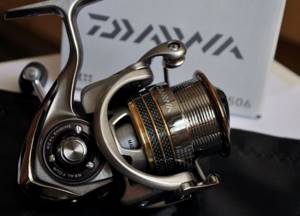
Daiwa Freams
Daiwa Crossfire
Daiwa Exceller
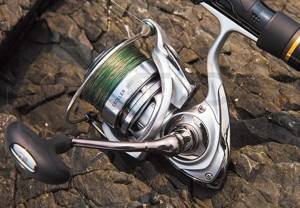
Daiwa Legalis
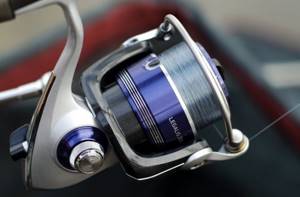
Daiwa Laguna
Daiwa Crest
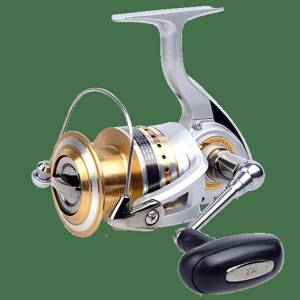
Daiwa Revros
Daiwa Sweepfire
Setting the drag of a spinning reel for fish
An equally important “tactical” task of the clutch is to avoid line breakage or spinning rod breakage when catching large fish. Released (within reasonable limits) the brake makes the fishing “softer” - that is, it better compensates for both the jerks of the predator and our possible mistakes. It comes to a seeming paradox: we turn the reel “towards ourselves”, but the fish manages to pull “back” even faster. In this situation, you can only break the fishing line or break the spinning rod on purpose.
In addition, the drag can also help in performing ultra-long power casts. For example, when fishing for asp, it may be necessary to send a fairly heavy spoon over a maximum distance. And this is only possible with a reasonably thin fishing line - which, however, may not withstand a sharp force cast. Preliminary weakening of the clutch to some extent “smoothes out” this powerful starting jerk.
However, weakening the clutch also weakens the hooking - after all, during a jerk, the load increases sharply, the spool rotates and loses a little line. And the actual fishing with a weak brake is sometimes unjustifiably delayed, and this is dangerous - the fish can go into the grass or snags.
It turns out that, depending on the specific fish and local conditions, “slipping” can be both useful and harmful. Therefore, the correct setting of the friction brake is almost always a reasonable compromise between hooking and retrieving. However, if there are any doubts, always “adjust” in favor of hooking - after all, during fishing, we will still have time, if necessary, to further loosen or tighten the brake.
For example, when fishing for pike and pike perch, due to their bony mouth and “bulldog” grip, a hard hook is always necessary. This means that the clutch must be tightened to the maximum. In addition, these predators usually try to go into the grass or snags - then only strong braking will help stop them.
And in general, it’s better to fish out small (up to 2 kg) “toothy” and “fanged” ones with force – without letting them come to their senses, because the strength of the tackle allows this. And if you suddenly come across a real “crocodile”, then even a tight clutch is a small hindrance for him. In addition, if necessary, it can always be weakened.
The opposite example is perch. Everyone knows that the “striped” has rather weak lips - which sometimes you pull out instead of fish. To prevent this from happening, hooking and landing the perch must be delicate, which is ensured by appropriately weakening the friction brake. A “hard” brake is not needed when catching predators such as asp, ide and chub. After all, these fish have a fleshy mouth and are well caught, often even without hooking. However, after this, the asp and chub usually make a sharp jerk, and the “soft” clutch helps to restrain this dangerous first impulse. The ide has a habit of “tumbling” when fishing, and the adjusted brake here also neutralizes all dangerous jerks.
Therefore, before starting each fishing trip, it is necessary to again set the appropriate value of the friction brake and, during fishing, adjust it if necessary, but in no case exceeding the “safe maximum”. Naturally, the same must be done when installing a new spool - especially with thinner line - which some people sometimes forget about.
How to install a reel on a spinning rod
The versatility of the fastening elements of the rod and the mechanism itself allows you to reliably and quickly install a reel on a spinning rod. On spinning rods, the design provides for the presence of a so-called fastening leg, and on the butt of a spinning rod there is a device for gripping this part of the reel.

It is worth noting that the fastening mechanism on a spinning rod can be made in two versions: a device using a worm gear and a device based on gripping the leg with the force of spring clamps. Preference should be given to fasteners based on a worm gear. Before installing the reel, check the dimensions of the support legs of the mechanism and the mounting sockets on the fishing rod.
Important! The leg should fit tightly, but without tension, into the mounting grooves.
The mount on the butt of the tackle is moved apart to allow the reel to be positioned freely and is clamped with such force that when swinging the rod you do not feel any play or swaying of the mechanism. Excessive clamping can lead to deformation and cracks on the clamping elements or breakage of the leg support.

